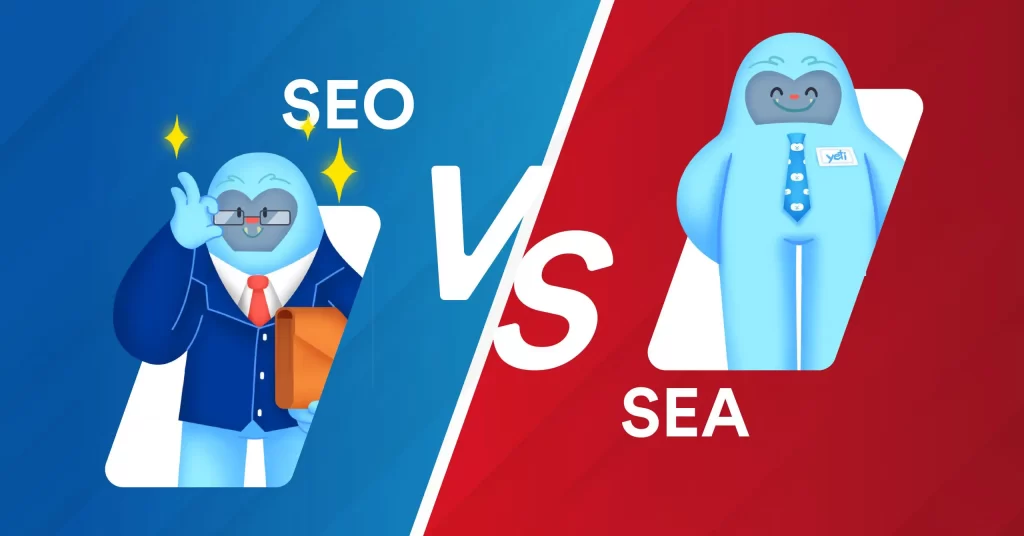One of the main objectives of any commercial website is to be positioned as high as possible among Internet search results. In fact, the more sub-pages appear in search engine results pages (SERPs for short ), the more your traffic (number of visitors) will increase. This visibility depends above all on search engines such as Google or Bing, and on the application of Search Engine Marketing (SEM) criteria and its two branches: paid search (SEA, acronym for Search Engine Advertising) and natural search (SEO, Search Engine Optimization).
An administrator can thus generate clicks and see his conversion rate increase (the process of converting visitors into buyers) thanks to paid advertising placement on search engines and targeted optimization of the home page for natural referencing. As online marketing tools, SEO and SEA play different roles. Nevertheless, a complete SEM strategy should take into account the synergy effects of SEM, to find the right balance between SEA and SEO.

SEO vs. SEA: content-driven differentiation
The results of a successful SEM strategy are directly reflected in the search engine results. When an Internet user makes a query on a search engine, a listing is established based on the keywords that have been searched for: this is natural referencing. There’s also a selection of online advertising: this is called paid search. With these paid ads, companies can secure a strategic position and appear among the top search results based on the keywords used. These measures therefore fall within the domain of SEA (Search Engine Advertising).
The main ranking criterion for naturally optimized search results, on the other hand, depends on the relevance of the content to the search query. These criteria are specific to each search engine and depend on a mathematical algorithm. A good ranking in organic (naturally optimized) search results is based on criteria specific to search engines, and SEO (search engine optimization) tools. These two techniques, SEA and SEO, differ greatly in terms of cost, objectives, measurability and sustainability.
What is paid search?
The aim of search engine advertising placement is to increase traffic and ensure branding. Advertising is displayed according to the offer, optimized text display and criteria of relevance to the user’s search. The advantage of SEA lies in the measurability of return on investment, high transparency and excellent management of the advertising actions implemented. The duration of an ATS campaign varies according to the budget allocated. A SEA campaign can be a one-off or a long-term project. A high budget for an SEA strategy is compensated by fast, visible results. What’s more, the use of complementary analysis tools opens up a wealth of targeting and retargeting possibilities.
- SEA is best suited to short-term campaigns and projects where results need to be visible and measurable quickly.
- SEA measures are above all transactional: the main criterion for the success of such a strategy is the visitor conversion rate.

What is search engine marketing?
SEO includes both onpage and offpage measures that improve a site’s visibility in search engine rankings and increase its visibility naturally. While off-page SEO measures are primarily based on optimizing backlinks, on-page SEO aims to optimize a site’s content and page structure for better evaluation by search engines. These two areas of SEO are aimed at achieving a high ranking in search engine results pages(SERPs).
But, unlike an SEA strategy, the desired result cannot always be guaranteed. What’s more, SEO strategies are not as transparent and easy to manage as those for SEA. However, SEO has the advantage of not incurring fixed costs. An SEO strategy takes time to implement, but the results are visible over the long term, and the branding effect can be achieved this way too.
- SEO is designed for the permanent, long-term optimization of a website.
- In addition to improving performance through conversion rates, SEA focuses on increasing a website’s visibility.
How to master synergy effects in SEM
Despite the differences between SEO and SEA, both strategies can help you achieve greater visibility on the Web. The more a web page appears in a search query, the greater the chance that users will click on it. Depending on the circumstances, it is therefore advisable to combine SEO and SEA strategies.
With the right balance between SEO and SEA, webmasters benefit from the synergy effects of SEM. The following points can be observed:
- Data sharing ;
- Keyword strategy overlays ;
- Web page optimization through SEA measures ;
- Multi-listing strategy: be visible on all fronts, both in naturally referenced results and in paid search.
An extended database through integrated analysis of performance indices
Specific SEM tools provide website administrators with measurable data, enabling better planning and more effective implementation of measures to be taken. If you tailor your SEM strategy to the most popular search engine in France, Google, the tools offered by this search engine will be a great help. These include Google Analytics, Google AdWords and Google Webmaster-Tools (GWT). Google Analytics lets you analyze your SEO and SEA performance indicators.
The Google Webmaster-Tool lets you find out which keywords your website is referenced for, and how much traffic is generated from these keywords. However, the analysis offered by GWT does not measure visitor conversion rates. That’s why we also recommend using tools like Google Analytics and AdWords. In this way, the results obtained from natural search engine optimization (SEO), measurable with AdWords, can be compared with those obtained from paid search engine optimization (SEA). An administrator can then track and analyze the “path activity” of visitors to their page, i.e. the customer’s journey from page to page on the site, right up to the act of purchase(Customer Journey). Relevanttouchpoints with the site’s offer can also be identified to better adapt future SEM strategies.
Interactions between SEM and SEA keyword strategies
These two areas of SEM include measures based on a keyword strategy. These keywords determine both the site’s page structure and its optimization, as well as the construction of a search engine advertising campaign. Overlapping keyword lists can occur with frequently searched terms, especially among “Short Tail” (short expressions with high search and competition potential) and “Mid Tail” (expressions of two to three words, with less competitive search potential) keywords. This is why an SEO keyword analysis is also appropriate before launching a SEA campaign.
However, with “Long Tail” keyword combinations (a large number of terms consisting of 2 or 3 words), traffic is qualified but low.. For information on search volumes and keyword trends, a tab called Keyword-Planer in Google AdWords. When an AdWords campaign is launched based on specific keywords, the planning tool delivers detailed data on the conversion rate of visitors and the extent to which this rate is achieved. This makes it possible to identify the most relevant keywords for SEO action.
As online advertising with Google works on a CPC (cost per clickIn order to reduce costs, it’s advisable to use less sought-after (and therefore less expensive) keywords in SEA, and to cover SEO with highly sought-after keywords that would be more expensive. SEA is therefore better suited to “Long Tail” keyword combinations, as the long-term costs are lower. An ATS strategy based on “Long Tail” keywords is also interesting for new Web projects that are not yet well referenced naturally. It’s also possible to reduce SEA spending as SEO results increase.
Search engine optimization with SEA
AdWords campaigns offer a wealth of information for optimizing a website based on criteria relevant to search engines. To achieve a high click-through rate, online advertising is based on a process of constant improvement of display texts and landing pages. At the heart of this process is the marketing technique of A/B testing, which consists of proposing several advertising variants for the same keyword, in order to improve the conversion rate and see what works best.
This technique makes it possible to optimize advertisements and draw conclusions about the SEO measures to be implemented. Snippets (i.e. the excerpt of the page that appears in the results, including the title and description) have a major influence on the click-through rate, as they help Internet users to assess whether the destination page is relevant to their search. Successful ad optimization measures also apply to naturally optimized landing pages and meta tags (invisible HTML commands, one of the components to be taken into account when referencing a site).
Overlapping SEO and SEA: more visibility through a multi-listing strategy
Multi-listing means being visible in both natural and paid search results. Such prominence in the SERPs greatly enhances branding and visibility. What’s more, multi-listing reinforces consumer confidence in a brand, and such a marketing strategy ensures good positioning in natural referencing. The extent to which such a strategy is implemented is strongly correlated with the website administrator’s budget. Other alternatives to a multi-listing strategy are ads in Google Shopping, Google Images or the Google Knowledge-Graph, which the search engine sometimes includes in its search results.





